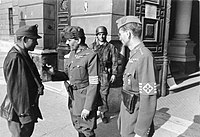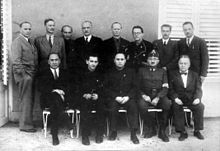Government of National Unity (Hungary)

The Government of National Unity (Nemzeti Összefogás Kormánya)[1] was the name used by the government of the Kingdom of Hungary between October 1944 and March 1945. This government, formed by the Arrow Cross Party, was established on 16 October 1944 after Regent Miklós Horthy was removed from power during Operation Panzerfaust (Unternehmen Eisenfaust) [2]. Arrow Cross leader Ferenc Szálasi was Prime minister and Head of state (as Nation Leader). During the Arrow Cross' short rule, ten to fifteen thousand Jews were murdered outright,[3] and 80,000 Jews, including many women, children and elderly were deported from Hungary to their deaths in the Auschwitz concentration camp.[4].
Hungary splits in two


Under duress, Miklós Horthy appointed Ferenc Szálasi as magyar királyi miniszterelnök (Royal Hungarian Prime Minister) and was deported afterwards by the Germans. The Hungarian parliament approved the formation of a Council of Regency (Kormányzótanács) of three. On november 4, Szálasi was sworn as Nation Leader (nemzetvezető)[5]. He formed a government of sixteen ministers, half of which were members of the Arrow Cross Party. While the Horthy regency had come to an end, the Hungarian monarchy was not abolished by the Szálasi regime, as government newspapers kept referring to the country as the Kingdom of Hungary (Magyar Királyság, also abbreviated as m.kir), although Magyarország (Hungary) was frequently used as an alternative[6][7].
Szálasi was an ardent fascist, and his "Quisling" government had little other intention or ability but to maintain fascism and to maintain control in Nazi-occupied portions of Hungary as the Soviet Union invaded. He did this in order to reduce the threat to Germany. Szálasi's aim was to create a single-party state based on his "Hungarist" ideology.
On 21 December 1944, with the approval of the Soviet Union, Béla Miklós was elected as the Prime Minister of a "counter" Hungarian government in Soviet-controlled Debrecen. Miklós was a former commander of the Hungarian First Army. He had failed in his efforts to convince many of the men under his command to switch sides. The government that Miklós oversaw was an "interim government" and maintained control in the Soviet-occupied portions of Hungary.
History

Upon the total Nazi and Fascist takeover, Hungary faced impending occupation by the Soviet Union which resulted in German armed forces destroying Hungarian infrastructure as the Red Army closed in.
In cooperation with the Nazis, Szálasi restarted the deportations of Jews, particularly in Budapest. Thousands more Jews were killed by Arrow Cross members. Of the approximately 800,000 Jews residing within Hungary's expanded borders of 1941, only 200,000 (about 25%) survived the Holocaust.[8] Several thousand Roma people were also killed as part of the Porajmos. Anne McCormick, a foreign correspondent for The New York Times wrote in defense of Hungary as the last refuge of Jews in Europe, declaring that “as long as they exercised any authority in their own house, the Hungarians tried to protect the Jews.”[9]
Szálasi envisioned a new economic order, which he called the "Corporate order of the Working nation". Even as Hungary was in chaos, Szálasi refused theoretically to compromise Hungarian sovereignty, trying to retain nominal command of all Hungarian military units, including the local SS units. Ethnic Germans were still not allowed to join the Arrow Cross Party. Szálasi devoted much time to his political writings and to trips in the shrinking territory under his control : many political matters were effectively handled by his Deputy Prime Minister Jenő Szöllősi[10]. At the beginning of December, Szálasi and his government relocated out of Budapest as Soviet troops advanced towards the capital.
In December 1944, the Battle of Budapest began. Fascist forces loyal to Szálasi and the badly damaged remnants of the Hungarian First Army fought alongside German forces. They fought against the Red Army to no avail. By 13 February 1945, all of Budapest was under Soviet control[11].
In March 1945, during Operation Spring Awakening (Unternehmen Frühlingserwachen), Fascist Hungarian forces of the Hungarian Third Army fought alongside German forces in the last major offensive in Hungary against the Soviet forces. For ten days the Axis forces made costly gains. However, within twenty-four hours, the Soviet counterattack was able to drive the Germans and Hungarians back to the positions they held before the offensive began.
Between 16 March and 25 March 1945, the remnants of Hungarian Third Army was overrun and virtually destroyed. By the end of March and into April, what remained of the Hungarian armed forces were put on the defensive during the Nagykanizsa–Kermend Offensive and were then forced into Slovakia and Austria as Soviet forces occupied all of Hungary. Béla Miklós's government was nominally in control of the whole country. Nazi Germany itself was on the verge of collapse.
The Ferenc Szálasi regime, which had fled Hungary, was dissolved in 1945 after Germany's surrender. Szálasi was captured by American troops and returned to Hungary, where he was tried for crimes against the state, and executed.
Government members

- Ferenc Szálasi, Prime minister and Head of state ("Nation Leader")
- Jenő Szöllősi, Deputy Prime minister
- Gábor Vajna, Interior minister
- Gábor Kemény, Minister of foreign affairs
- Lajos Reményi-Schneller, Minister of finance
- László Budinszky, Secretary for Justice
- Károly Beregfy, Minister of Defence
- Ferenc Rajniss, Minister of Education
- Fidél Pálffy, Secretary of Agriculture
- Lajos Szász, Secretary of Commerce and transportation
- Emil Szakváry, Secretary of Industry
- Béla Jurcsek, Secretary of Public care
- Emil Kovarcz, Minister without department in charge of the full-scale mobilization and arming of the Nation
- Ferenc Kassai-Schalmayer, Minister without department for Nation Defence and Propaganda
- Vilmos Hellebronth, Minister without department in charge of the continuous oversight of production
- Árpád Henney, Minister and special delegate to the Nation Leader, in charge of the Nation Leader's task force
See also
References
- ^ Nemzeti Összefogás Kormánya, Szálasi-kormány, nyilas kormány
- ^ The Policies of Prime Minister Kallay and the German Occupation of Hungary in March 1944
- ^ Patai, Raphael (1996). The Jews of Hungary:History, Culture, Psychology. 590: Wayne State University Press. p. 730. ISBN 0814325610.
{{cite book}}: CS1 maint: location (link) - ^ Johnston, Chris (2006-02-16). "War Crime Suspect Admits to his Leading Fascist Role". The Age. Retrieved 2009-04-19.
- ^ Hungary: Notes - archontology.org
- ^ Budapesti Közlöny, 17 October 1944
- ^ Hivatalos Közlöny, 27 January 1945
- ^ Victims of Holocaust - Holocaust Memorial Centre.
- ^ Mrs. Anne O'Hare McCormick, The New York Times of July 15, 1944. Original context: "It must count in the score of Hungary that until the Germans took control it was the last refuge in Central Europe for the Jews able to escape from Germany, Austria, Poland and Rumania. Now these hopeless people are exposed to the same ruthless policy of deportation and extermination that was carried out in Poland. But as long as they exercised any authority in their own house, the Hungarians tried to protect the Jews." See: http://historicaltextarchive.com/books.php?op=viewbook&bookid=7&cid=8
- ^ Stanley G. Payne, A history of fascism, 1914-1945, Routledge, 1996, page 420
- ^ The Policies of Prime Minister Kallay and the German Occupation of Hungary in March 1944
